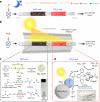Direct air capture of CO2 for solar fuel production in flow
- PMID: 40291483
- PMCID: PMC12021658
- DOI: 10.1038/s41560-025-01714-y
Direct air capture of CO2 for solar fuel production in flow
Abstract
Direct air capture is an emerging technology to decrease atmospheric CO2 levels, but it is currently costly and the long-term consequences of CO2 storage are uncertain. An alternative approach is to utilize atmospheric CO2 on-site to produce value-added renewable fuels, but current CO2 utilization technologies predominantly require a concentrated CO2 feed or high temperature. Here we report a gas-phase dual-bed direct air carbon capture and utilization flow reactor that produces syngas (CO + H2) through on-site utilization of air-captured CO2 using light without requiring high temperature or pressure. The reactor consists of a bed of solid silica-amine adsorbent to capture aerobic CO2 and produce CO2-free air; concentrated light is used to release the captured CO2 and convert it to syngas over a bed of a silica/alumina-titania-cobalt bis(terpyridine) molecular-semiconductor photocatalyst. We use the oxidation of depolymerized poly(ethylene terephthalate) plastics as the counter-reaction. We envision this technology to operate in a diurnal fashion where CO2 is captured during night-time and converted to syngas under concentrated sunlight during the day.
Keywords: Carbon capture and storage; Photocatalysis; Solar fuels.
© The Author(s) 2025.
Conflict of interest statement
Competing interestsA patent application covering integrated direct air capture and utilization into solar fuels has been submitted on behalf of the University of Cambridge via its technology transfer office, Cambridge Enterprise with co-inventors S. Kar and E.R. (application no. GB2408950.0). The other authors declare no competing interests.
Figures





Similar articles
-
Technical, economic and environmental analysis of solar thermochemical production of drop-in fuels.Sci Total Environ. 2023 Nov 25;901:166005. doi: 10.1016/j.scitotenv.2023.166005. Epub 2023 Aug 2. Sci Total Environ. 2023. PMID: 37541501
-
Integrated CO2 Capture and Conversion to Formate and Methanol: Connecting Two Threads.Acc Chem Res. 2019 Oct 15;52(10):2892-2903. doi: 10.1021/acs.accounts.9b00324. Epub 2019 Sep 5. Acc Chem Res. 2019. PMID: 31487145
-
Integration of thermochemical water splitting with CO2 direct air capture.Proc Natl Acad Sci U S A. 2019 Dec 10;116(50):25001-25007. doi: 10.1073/pnas.1915951116. Epub 2019 Nov 21. Proc Natl Acad Sci U S A. 2019. PMID: 31754029 Free PMC article.
-
A Review of Oxygen Carrier Materials and Related Thermochemical Redox Processes for Concentrating Solar Thermal Applications.Materials (Basel). 2023 May 7;16(9):3582. doi: 10.3390/ma16093582. Materials (Basel). 2023. PMID: 37176464 Free PMC article. Review.
-
Syngas Production from CO2 and H2O via Solid-Oxide Electrolyzer Cells: Fundamentals, Materials, Degradation, Operating Conditions, and Applications.Chem Rev. 2024 Apr 24;124(8):5119-5166. doi: 10.1021/acs.chemrev.3c00760. Epub 2024 Apr 15. Chem Rev. 2024. PMID: 38619540 Review.
Cited by
-
Economic and sustainable revolution to facilitate one-carbon biomanufacturing.Nat Commun. 2025 May 27;16(1):4896. doi: 10.1038/s41467-025-60247-w. Nat Commun. 2025. PMID: 40425587 Free PMC article. Review.
References
-
- Sanz-Pérez, E. S., Murdock, C. R., Didas, S. A. & Jones, C. W. Direct capture of CO2 from ambient air. Chem. Rev.116, 11840–11876 (2016). - PubMed
-
- McQueen, N. et al. A review of direct air capture (DAC): scaling up commercial technologies and innovating for the future. Prog. Energy3, 032001 (2021).
-
- Erans, M. et al. Direct air capture: process technology, techno-economic and socio-political challenges. Energy Environ. Sci.15, 1360–1405 (2022).
-
- Chauvy, R. & Dubois, L. Life cycle and techno-economic assessments of direct air capture processes: an integrated review. Int. J. Energy Res.46, 10320–10344 (2022).
-
- Bui, M. et al. Carbon capture and storage (CCS): the way forward. Energy Environ. Sci.11, 1062–1176 (2018).
LinkOut - more resources
Full Text Sources
Miscellaneous
